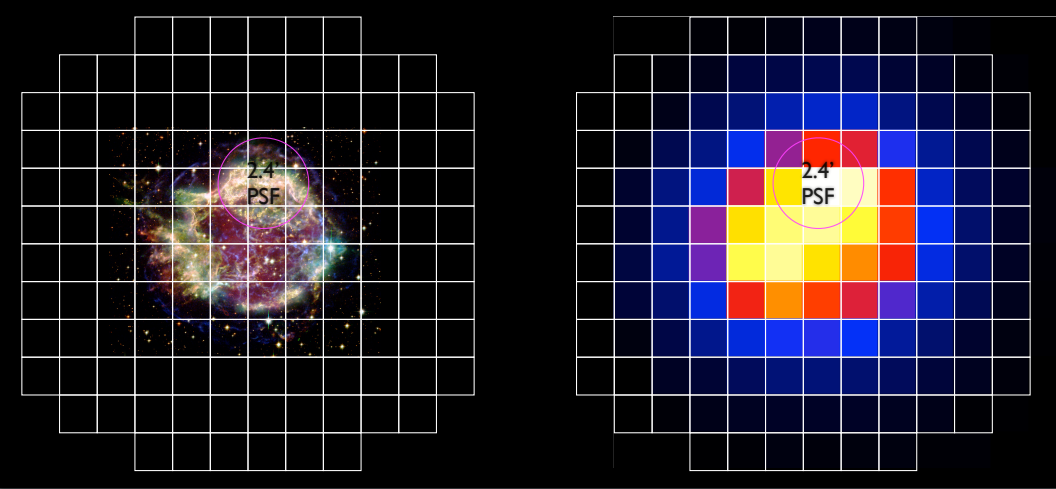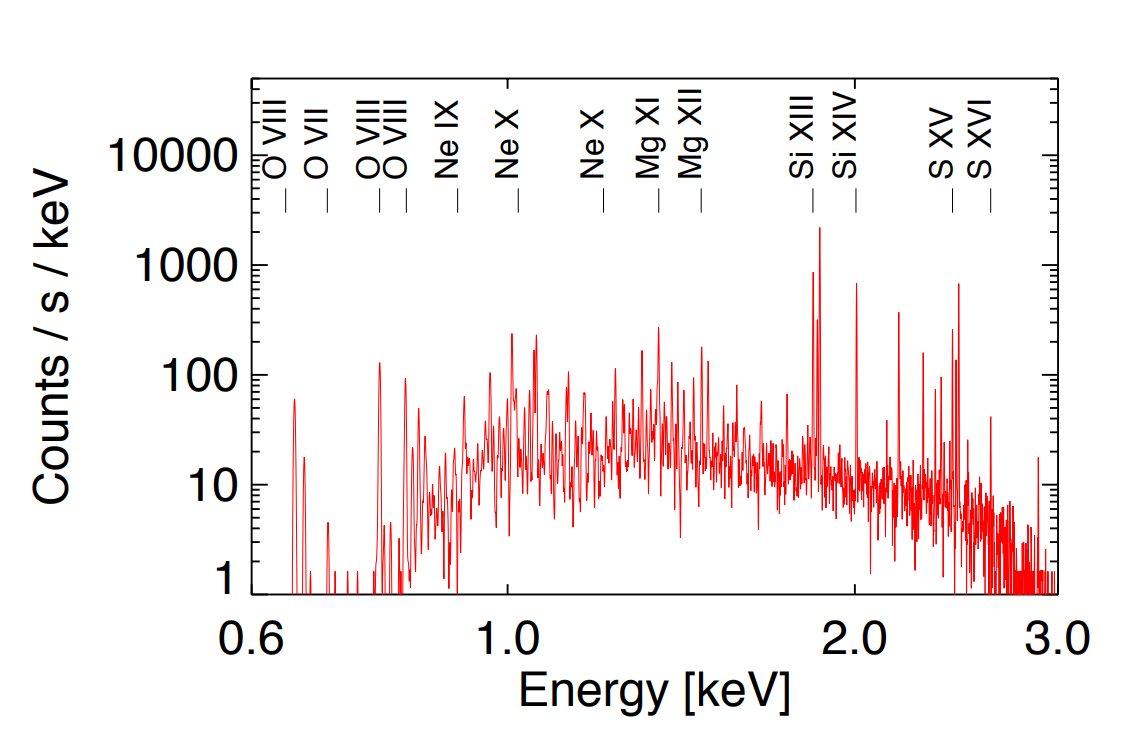The Micro-X Target: The Cassiopeia A Supernova Remnant

Cassiopeia A (Cas A) is a target well-suited to studying the physical processes that occur in core-collapse Supernova Remnants (SNRs).It is a very bright target located at a well-constrained distance of 3.4 kpc. It is the product of a Type IIb supernova, and at ~340 years old, it is the second youngest known SNR in our galaxy.
The brightest emission in Cas A is within the radius where stellar ejecta are illuminated after being pushed outward, then compressed and heated by the reverse shock, forming the 200" diameter "Bright Ring". Iron-rich ejecta are unexpectedly observed futher out from the center than silicon-rich ejecta; this may be an overturning of ejecta layers in the explosion because heavier elements are formed in the very core of the supernova. Figure 1 shows a Chandra observation of Cas A's expanding shell of hot gas.
The physical conditions of the SNR are studied by determining the ionization state of the plasma. At X-ray energies, this means studying the line fluxes of the hydrogen- and helium-like emission from abundant elements (e.g., Si, Mg, and the range of Fe ions from Fe XVII to Fe XXVI). The Si XIII triplet (~1.85 keV) will be the strongest emission line complex seen by Micro-X.
Micro-X's high-resolution observation of Cas A will allow the study of previously-entangled emission lines for the first time. Micro-X simulations project ~13,000 counts incident upon the array in a 300 second observation, as shown in Figure 2. The resulting simulated spectrum is shown in Figure 3.
Micro-X will be the first instrument to test if the plasma states are the same for Fe- and Si-rich ejecta by disentangling the Fe-L forest and Ne emission between ~1-1.5 keV. This analysis cannot be done with either Chandra ACIS (low spectral resolution) or Chandra HETG.
Ni and Fe are particularly important for understanding nucleosynthesis during the supernova. In the outer regions of the SNR, Ni-L emission may be observed for the first time, disentangled from the abundant Fe-L emission in the outer region. The Micro-X spectrum will be used with the Chandra ACIS and HETG spectra to model abundance, ionization, and Doppler structures to obtain average plasma conditions for several parts of the remnant.
Micro-X will also help to solve the "oxygen problem" in SNRs. Cas A is an oxygen-rich SNR, with strong strong oxygen emission at optical wavelengths. The actual amount of oxygen in Cas A is an unknown due to absorption and the limited energy resolution of CCD detectors. The presence of an oxygen-driven continuum in the X-ray emission spectrum is a point of debate, and Micro-X will help to solve this issue by constraining the amount of oxygen in Cas A through its measurement of O VII and O VIII lines, as shown in Figure 3.
The goals for the Micro-X observation of Cas A are to:
- Determine the line flux and associated temperature of observed Fe-L emission
- Perform plasma diagnostics and measure velocities of discrete ejecta knots
- Provide a global elemental assay for Cas A
- Measure the dynamic width of the Bright Ring
Cas A is a complex object with structure on multiple spatial scales and typical knot sizes on a 1" scale. Micro-X will observe emission from multiple ejecta, each with their own Doppler-shifted velocity. It will only be sensitive to the brightest knots and emission lines in a single flight. The brightest lines are expected to produce 10's of counts in a single observation, providing the statistics for a velocity resolution of ~150 km/s. At least 5 pixels in the array are projected to achieve statistically strong kinematic results (with very good signal-to-noise and clear Doppler structure). In addition to measuring individual ejecta knot Doppler velocities, Micro-X will measure the dynamical width of the Bright Ring from the assortment of low-level emission that broadens spectral lines. This Micro-X result from observations of high temperature (T = 107K) gas will be compared to a Spitzer spectrum showing a dynamical width of ~1000 km/s for the comparatively low (T = 104K) un-decelerated ejecta comprising the Bright Ring. This comparison will determine how strong of an effect post-shock deceleration and turbulence are on X-ray-emitting ejecta.

Figure 3: Simulated global spectrum of Cas A from co-adding all pixels. The high resolution observation will allow sensitivity to new physics.
